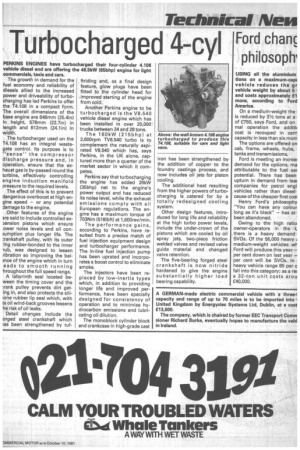PERKINS ENGINES have turbocharged their four-cylinder 4.108 vehicle diesel and
Page 11

If you've noticed an error in this article please click here to report it so we can fix it.
are offering the 48.5kW (65bhp) engine for light commercials, taxis and cars.
The growth in demand for the fuel economy and reliability of diesels allied to the increased power and driveability of turbocharging has led Perkins to offer the T4.108 in a compact form. The overall dimensions of the base engine are 646mm (25.4in) in height, 576rnm (22.7in) in length and 612mm (24.1in) in width.
The turbocharger used on the T4.108 has an integral wastegate control. Its purpose is to "sense" the compressor discharge pressure and, in operation, ensure that the exhaust gas is by-passed round the turbine, effectively controlling engine induction manifold pressure to the required levels.
The effect of this is to prevent dangerous overboost at high engine speed — or any potential damage to the engine.
Other features of the engine 3re said to include controlled exJansion pistons which ensure ower noise levels and oil coniumption plus longer life. The :trankshaft pulley, with its outer -ing rubber-bonded to the inner nib, was designed to lessen ribration so improving the balince of the engine which in turn eads to smooth running hroughout the full speed range.
A labyrinth seal located beween the timing cover and the :rank pulley prevents dirt geting in, and also protects the sili:one rubber lip seal which, with ts oil wind-back grooves lessens he risk of oil leaks.
Detail changes include the orged steel crankshaft which as been strengthened by tuf . ftriding and, as a final design feature, glow plugs have been fitted to the cylinder head for 'improved starting of the engine from cold.
Another Perkins engine to be turbocharged is the V8.540 vehicle diesel engine which has been installed in over 20,000' trucks between 24 and 28 tons.
The 1 6 OkW (2 1 5bhp) at 2,600rpm 1V8.540 turbo is to complement the naturally aspi rated V8.540 which has, says Perkins, in the UK alone, cap tured more than a quarter of the market sector in which it competes.
Perkins say that turbocharging the engine has added 26kW (35bhp) net to the engine's power output and has reduced its noise level, while the exhaust emissions comply with all
European regulations. The engine has a maximum torque of
703Nm (518Ibft) at 1,600rev/min.
The performance gains, according to Perkins, have re sulted from a precise match of fuel injection equipment design and turbocharger performance.
The in-line fuel injection pump has been uprated and incorporates a boost control to eliminate smoke.
The injectors have been replaced by low-inertia types which, in addition to providing
longer life and improved performance, have been specially
designed for consistency of operation and to minimise hydrocarbon emissions and lubricating oil dilution.
The monoblock cylinder block and crankcase in high-grade cast
iron has been strengthened by the addition of copper to the foundry castings process, and now includes oil jets for piston cooling.
The additional heat resulting from the higher powers of turbocharging is catered for by a totally redesigned cooling system.
Other design features, introduced for long life and reliability at the high turbo power levels, include the under-crown of the pistons which are cooled by oil spray jets, two-piece friction welded valves and revised valve guide material and changed valve retention.
The five-bearing forged steel crankshaft is now nitride hardened to give the engine substantially higher load bearing capability.
























































